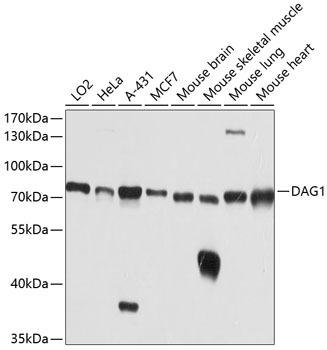-
Product Name
DAG1 Polyclonal Antibody
- Documents
-
Description
Polyclonal antibody to DAG1
-
Tested applications
WB
-
Species reactivity
Human, Mouse, Rat
-
Alternative names
DAG1 antibody; 156DAG antibody; A3a antibody; AGRNR antibody; DAG antibody; MDDGA9 antibody; MDDGC7 antibody; MDDGC9 antibody; dystroglycan antibody
-
Isotype
Rabbit IgG
-
Preparation
Antigen: Recombinant fusion protein containing a sequence corresponding to amino acids 654-749 of human DAG1 (NP_004384.4).
-
Clonality
Polyclonal
-
Formulation
PBS with 0.02% sodium azide, 50% glycerol, pH7.3.
-
Storage instructions
Store at -20℃. Avoid freeze / thaw cycles.
-
Applications
WB 1:500 - 1:1000
-
Validations

Western blot - DAG1 Polyclonal Antibody
Western blot analysis of extracts of various cell lines, using DAG1 antibody at 1:1000 dilution.Secondary antibody: HRP Goat Anti-Rabbit IgG (H+L) at 1:10000 dilution.Lysates/proteins: 25ug per lane.Blocking buffer: 3% nonfat dry milk in TBST.Detection: ECL Basic Kit .Exposure time: 5s.
-
Background
The dystroglycan complex is involved in a number of processes including laminin and basement membrane assembly, sarcolemmal stability, cell survival, peripheral nerve myelination, nodal structure, cell migration, and epithelial polarization.; Alpha-dystroglycan is an extracellular peripheral glycoprotein that acts as a receptor for both extracellular matrix proteins containing laminin-G domains. Receptor for laminin-2 (LAMA2) and agrin in peripheral nerve Schwann cells.; Beta-dystroglycan is a transmembrane protein that plays important roles in connecting the extracellular matrix to the cytoskeleton. Acts as a cell adhesion receptor in both muscle and non-muscle tissues. Receptor for both DMD and UTRN and, through these interactions, scaffolds axin to the cytoskeleton. Also functions in cell adhesion-mediated signaling and implicated in cell polarity.; (Microbial infection) Alpha-dystroglycan acts as a receptor for lassa virus and lymphocytic choriomeningitis virus glycoprotein and class C new-world arenaviruses. Alpha-dystroglycan acts as a Schwann cell receptor for Mycobacterium leprae, the causative organism of leprosy, but only in the presence of the G-domain of LAMA2.
Related Products / Services
Please note: All products are "FOR RESEARCH USE ONLY AND ARE NOT INTENDED FOR DIAGNOSTIC OR THERAPEUTIC USE"
